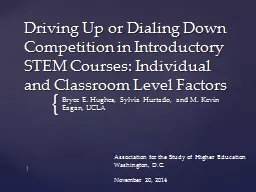

Bryce E Hughes Sylvia Hurtado and M Kevin Eagan UCLA Association for the Study of Higher Education Washington DC November 20 2014 1 Only 40 of STEM aspirants complete a STEM degree with most leaving within the first 2 years of college ID: 264248
Download Presentation The PPT/PDF document "Driving Up or Dialing Down Competition i..." is the property of its rightful owner. Permission is granted to download and print the materials on this web site for personal, non-commercial use only, and to display it on your personal computer provided you do not modify the materials and that you retain all copyright notices contained in the materials. By downloading content from our website, you accept the terms of this agreement.
Slide1
Driving Up or Dialing Down Competition in Introductory STEM Courses: Individual and Classroom Level Factors
Bryce E. Hughes, Sylvia Hurtado, and M. Kevin Eagan, UCLA
Association for the Study of Higher EducationWashington, D.C.November 20, 2014
1Slide2
Only 40% of STEM aspirants complete a STEM degree, with most leaving within the first 2 years of collegeFederal agencies and campus leaders are investing in teaching and learning innovations in
STEM to promote talent developmentPedagogy in introductory STEM courses is likely one cause of attrition: heavy use of lecture and promotion of a competitive environment
Introduction
2Slide3
To identify factors that contribute to competitiveness in introductory STEM coursesSpecifically, to test the relationship between “grading on a curve” and competitiveness
Also, to test other ways faculty influence a competitive environment in the classroom
Purpose3Slide4
Social Interdependence Theory (Johnson & Johnson, 1989):
People’s actions and outcomes are affected by the actions and decisions of othersCompetition: negative interdependence as individuals work to each other’s detriment
Goal Theory (Ames & Ames, 1984; Covington, 2000; Kaplan & Maehr, 2007):Performance goals are motivated by competition, drive to achieve
Mastery goals are motivated by rewards for effort and achievement of established criteria
Conceptual Framework
4Slide5
“Grading on a curve” has been identified as a contributing factor to competitiveness in STEM courses
Premed factorCompetitiveness detrimental to underrepresented groupsCompetitiveness may contribute to increased academic performance, but often distracts from course mastery
Most studies are of single or a small number of classrooms, or in laboratory settingsLiterature Review
5Slide6
Data source and sample:2753 students in 79 courses across 15 universities
Longitudinal: surveyed at start and end of Spring 2010 termFaculty survey, registrar data merged in
Methods:Descriptive statisticsHierarchical Linear Modeling (HLM)Methods
6Slide7
Dependent variableFrequency students perceived competitiveness in the course
Independent variablesGrading on a curve: proportion of A’s among final grades (lower proportion = grading on a curve)
Classroom-level variables (8): Faculty decisions about course structure and attitudes about teachingStudent-level variables (22): background characteristics, precollege preparation, self-concept, course experiences, co-curricular experiences
Variables
7Slide8
Classroom
-level variables
EffectSig.Proportion of A’s among final grades for course
—
*
Goal: Encourage collaboration
—
**
Attitude: Unqualified students in course
+
***
Agreement: With effort, all students
can learn material
+
*
Results: Classroom Level
8Slide9
Student background characteristics
Effect
Sig.Sex: Female
+
*
Premed student
+
*
HS
biology grade
—
*
Drive to achieve
+
**
Participation in pre-professional
or departmental club
+
**
Results: Student Level
9Slide10
Student-level
classroom experiences
EffectSig.Course is required for professional school admission
+
***
HPW studying with peers
+
**
Used
group work in class
+
**
Felt collaboration among peers in class
+
***
Felt hard work was reflected
in grades
—
*
Cross level effect with proportion
of A’s
+
*
Considered dropping
the course
+
***
Feel prepared for next course
in sequence+**
Results: Student Level
10Slide11
Figure: Cross-level effect
11
Proportion of
A’s among final
gradesSlide12
“Grading on the curve” contributes to perceptions of competitivenessFaculty can “dial down” competitiveness by structuring collaboration into courses
Peers use collaborative strategies to manage a competitive environmentProfessors’ attitudes toward learning and students’ self-perceptions also drive perceptions of competitiveness
Discussion & Conclusions
12Slide13
Faculty play an important role in establishing classroom environment regarding competitivenessCompetitiveness could be harnessed toward improving academic performance through careful design and implementation
Faculty should also be cognizant of effect of competitiveness on groups underrepresented in STEM, like women or URM students
Implications13Slide14
Contact Info
Faculty/Co-PIs:
Sylvia Hurtado
Kevin Eagan
Tanya
Figueroa
Bryce Hughes
Administrative Staff:
Dominique
Harrison
Graduate Research
Assistants
:
Website: www.heri.ucla.edu
E
-mail
:
heri@ucla.edu
Post-
Bacc
Research Analyst
:
Robert Paul
14
This study was made possible by the support of the National Institute of General Medical Sciences, NIH Grant
Numbers
1 R01 GMO71968-01 and R01 GMO71968-05, the National Science Foundation, NSF Grant Number
0757076
, and the American Recovery and Reinvestment Act of 2009 through the National Institute of General
Medical
Sciences, NIH Grant 1RC1GM090776-01. This independent research and the views expressed here
do
not indicate endorsement by the sponsors.